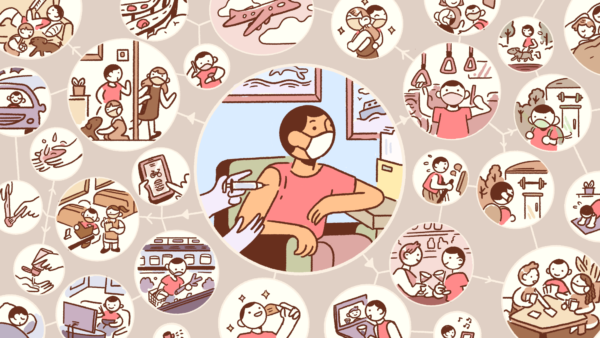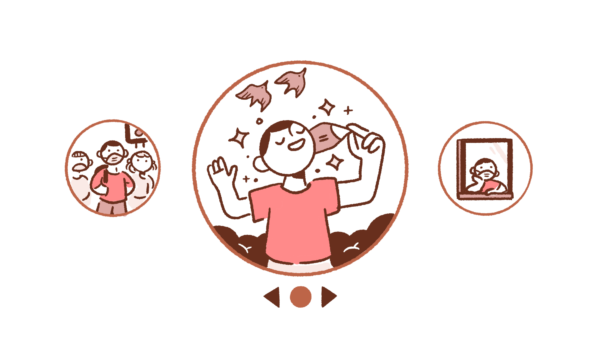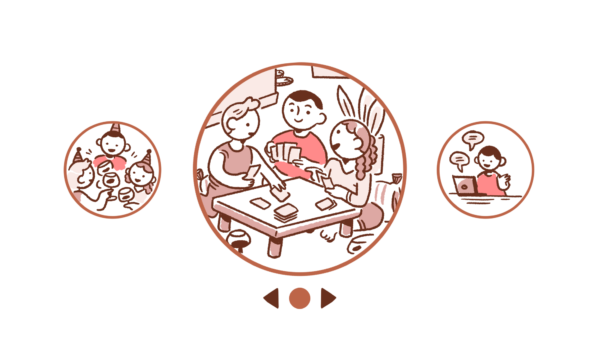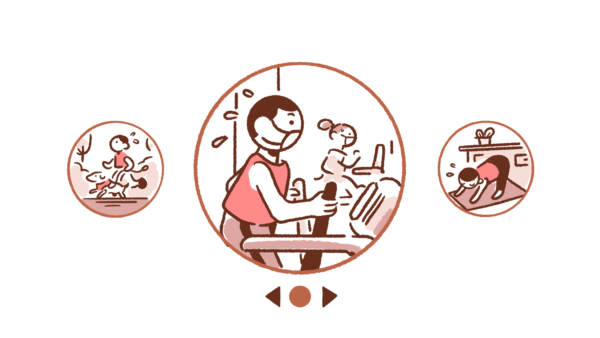
You got your shot and you’re ready to get back to normal life. But what does that mean anymore? While being fully vaccinated doesn’t mean it’s suddenly safe to party like it’s 2019, most interactions pose a much lower risk than they did before you got jabbed.
Remember, you don’t reach full vaccination until at least two weeks after getting your second dose of either the Pfizer or Moderna vaccine, or the one-shot Johnson & Johnson vaccine. So what kind of precautions do you still need to take after that?
The Centers for Disease Control and Prevention has laid out some guidelines. But for many interactions, “there is no set rule book,” says Dr. Cassandra Pierre, an infectious disease specialist at Boston Medical Center. “It really has to do with your risk tolerance.” And parents with kids too young to be eligible for vaccines will have somewhat different considerations.
As you go about rediscovering life outside the bunker, here are some things to keep in mind.
Experts say the vaccines are highly effective against the strains of the coronavirus currently dominant in the U.S. They’re not foolproof, but data so far show the protection is really strong. The slight remaining risk of infection will be higher if the virus is surging in your community or variants of concern are circulating widely. So stay aware of local conditions. And remember, the more people you interact with, the higher the potential risk of being exposed to the virus.
And finally, it’s not just about you. You can still pick up and potentially transmit the virus to unvaccinated people — and many Americans still aren’t vaccinated. What’s more, vaccines may be less effective in some people who are severely immunocompromised. So think about the risk of severe disease in the people you spend time with.
“Communication is the key here,” says Pierre. “Much like prior to vaccination, we all had to talk to each other to figure out what our individual risk and activities were and what our risk tolerance was.”
NPR spoke with nine infectious disease specialists and epidemiologists about the relative safety of various activities after full vaccination. Bottom line: “If you are fully vaccinated, you should feel good about participating in things that are important to you,” says Dr. Preeti Malani, an infectious disease specialist and chief health officer at the University of Michigan.
Just remember, you still want to behave in ways that reduce the risks for everyone.
With all that in mind, explore our frequently asked questions about life after vaccination.
Jump to a section: Masking; Hugs; Social Gatherings; Kid Questions; Travel; Indoor Dining; Weddings; Fitness & Self-Care

Masking
Do I still have to wear a mask in public?
The U.S. remains in a weird limbo period with many unvaccinated people, including children too young to get the shot — so when you are indoors in public spaces, like a mall or grocery store, mask up.
“The reality is [in public], we don’t know who’s vaccinated and who’s not,” notes Dr. David Aronoff, director of the division of infectious diseases at Vanderbilt University Medical Center.
When it comes to outdoors activities, the CDC released guidance Tuesday that vaccinated people do not need to wear masks outside except if they’re attending a crowded event. Research has consistently shown that the risk of transmitting the virus outdoors is far lower than indoors.
But keep a mask handy. Linsey Marr, a researcher at Virginia Tech who studies how viruses transmit in the air, says masking outdoors still makes sense if you are standing close to and talking to someone for more than a couple of minutes — and you don’t know their vaccination status.
“My general rules of thumb would be if I’m having a face-to-face conversation with someone and … they’re within arm’s reach for more than a minute or two, then I would mask,” Marr says.
Hugs
Can I hug a friend?
If you’re both fully vaccinated, hug away! “All of us are longing for that personal touch,” says Ravina Kullar, an infectious disease specialist and epidemiologist based in Los Angeles.
And if they’re not fully vaccinated? “If it’s somebody that I love and I want to give them a hug, I’m going to put on my mask and give them a hug, and then wash my hands. I never gave up hugging,” says Dr. Emily Landon, an infectious disease specialist and executive medical director for infection prevention and control at the University of Chicago School of Medicine.
OK, but my grandkids are too young to be vaccinated. Can I hug them?
“Yes, absolutely!” says Pierre, adding, “Do not squander immunity. Do the things that are going to bring you joy that you can absolutely safely do.”

Social gatherings
Can I hang out indoors mask-free with my friends if we are all fully vaccinated?
Yes, please do! If it’s a small group indoors and everyone is vaccinated, it’s safe to drop the masks and social distancing, according to guidelines from the CDC. But the CDC says you should still avoid medium and large-size gatherings.
How many people is too many when it comes to gathering indoors?
The CDC doesn’t give a hard number for gathering sizes. Malani and Pierre both suggest a good rule of thumb is no more than 10 people. Dr. Monica Gandhi, an infectious disease doctor at the University of California, San Francisco, suggests four households as a max. Remember, it all depends on the risk factors of the people present — what other risks they are exposed to on a daily basis, their own risk for severe disease, and their risk tolerance.
“If you have regular contact with someone who is immunocompromised or unvaccinated, then you may not want to be around more than a couple of people at a time to reduce the overall risk,” says Landon.
What about seeing my unvaccinated friends indoors?
The CDC says to limit your indoor interactions with unvaccinated people to just one other household at a time. The agency says you can go mask-free as long as no one in the unvaccinated household is at high risk of severe COVID-19. So if your two unvaccinated best friends live together, then yes, you can all hang out indoors at the same time. If they’re not roomies, it’s best to visit them one at a time.
Your kid questions
Are indoor playdates/hangouts OK if the adults are all vaccinated but the kids aren’t?
While younger children are at lower risk of severe disease if they do get infected, the risk “is not zero,” says Malani. And kids can transmit to others, so you still need to be thoughtful about your social bubble.
Outdoor playdates are safer, and Pierre says it’s probably fine to let the kiddos go maskless if they are outside, provided there aren’t variants of concern circulating widely in your community.
If you want the kids to play indoors, make sure you have an honest conversation with the other family about their risk factors. Did they just fly back from vacation in a spot where variants of concern are circulating widely? Do their kids play on a sports team that just had a COVID case? Have they had a sleepover at someone else’s house?
“The point is, you have shared risk and shared responsibility in terms of playdates,” Malani says.
As for how many families can join the indoor playdate? Given CDC guidelines about meeting up with unvaccinated households, Pierre suggests limiting it to one family at a time. Gandhi’s interpretation is more liberal: If the kids are all low risk and the adults are all vaccinated, she’d suggest no more than four households. “It’s ultimately about what your risk tolerance is,” Gandhi notes — though case rates in your community should help guide your decision making.
My relatives want to hold a family reunion. Is it safe for us to gather?
Yes, but keep it small and keep most of the activities outdoors if you can. “If you have a big family reunion, there’s going to be risk,” says Malani. ” It’s probably not a great time to hang out with 100 people. “
Make sure all the vulnerable adults in the family are vaccinated and again, talk openly about the kids’ risk factors. It might be a good idea to hold off on mask-less indoor playdates for a week or two before traveling to the reunion, Pierre says. For older kids, maybe they shouldn’t be spending a lot of time unmasked with a bunch of friends before they meet up with grandparents, Landon adds.
What about taking a vacation with my unvaccinated kids?
If it’s feasible, consider driving instead of flying, says Aronoff.
If you do fly, make sure your kids know how to wear a mask properly and keep their distance from other people. Pierre, the mother of 3-year-old twins, suggests avoiding longer flights because longer exposures pose potentially higher risks. Also, consider your sanity: It can be hard to keep young kids masked up and entertained on long-haul flights.
The biggest risk on flights is from the exhalations of nearby passengers, so seat your kids in between you and their other parent, not on an aisle, suggest Aronoff and Gandhi.
Avoid busy theme parks or crowded indoor activities at your destination. One other thing to consider: Will your kids have to quarantine once they’re back home or refrain from school sports or other activities? “Make sure you understand all the implications of traveling with your unvaccinated children,” Landon says.
Travel
Is it safe to fly domestically?
Yes, according to the CDC. But you still have to wear a mask, in part to keep other travelers safe, but also yourself, “because who wants a cold on vacation?” Landon notes. Also, try to keep physically distanced and avoid crowds, and monitor yourself for any symptoms a few days after you arrive. The CDC does not require vaccinated domestic travelers to quarantine after travel, unless you have symptoms.
That said, until the majority of the U.S. is vaccinated, experts say the threshold for travel should be higher than usual. Consider why you are traveling and how important it is, says Dr. Saad Omer, director of the Yale Institute for Global Health. “Don’t gather your square dancing group and go for a field trip,” he says. But if you need to get away for your mental health or you haven’t seen your mother in a year, go ahead.
What about international travel?
It’s far more complicated. You have to know the rules of the country you’re going to. Many still require you to quarantine when you arrive and/or show a negative COVID-19 test. The other thing to remember is, you’ll need a negative test to get back into the U.S.
The CDC says traveling abroad poses added risk, even for fully vaccinated travelers. For example, you could be exposed to new virus variants of concern and potentially bring them back with you. The agency’s list of very high risk foreign destinations is very long.
Finally, you have to consider the health system in the country you’re visiting. Is it overwhelmed with COVID-19 cases? “You may not get COVID, but if you get a heart attack or break your leg, that may not be a great place to be,” says Dr. Henry Wu, an infectious disease specialist and head of the TravelWell Center at Emory University.
Fitness & Self-Care Services

Can I go back to the gym?
If you’re fully vaccinated, the risk of a gym visit is moderate, says Pierre — provided you stick to the machines, keep your mask on and maintain physical distance from other gym goers.
But keep in mind, for the unvaccinated, gyms are “one of the highest-risk settings,” says Malani. That’s because exercise involves heavy breathing that can send respiratory particles flying into the air. Indoor fitness classes seem to be particularly risky: Multiple outbreaks in the U.S. and abroad have been tied to indoor group classes, even when physical distancing was in place.
Of course, lack of exercise is also a big risk to health long term — which is why Gandhi says she’s told her octogenarian parents to head back to the gym now that they’re fully vaccinated. “They lost some muscle mass in this last year and it’s worrying me,” Gandhi says of her parents — though she advised them to go at times it is unlikely to be crowded.
If you do go, make sure your gym is still operating at reduced capacity, has proper spacing between machines and enforces mask wearing, which protects unvaccinated staff or other guests. The experts we spoke with agreed it’s best to avoid indoor group classes for now: It can be hard to maintain distance in these classes, which often require you to jump, lunge or dance around.
Is it safe to get a massage or other service that requires close contact with a technician?
Yes, go get that self-care, says Malani. “If you’re both masked, it’s safe and I think there’s good data to show that.” She points to a study published last summer that found no transmission of the coronavirus among 139 clients exposed to two hairdressers with confirmed COVID-19 at a salon where everyone was required to be masked. “The risk is higher to the technician than you because of the number of people they’re exposed to,” she notes. So keep your mask on to keep them safe.
What about lip waxing or other services that requires me to remove my mask?
If a service requires you to remove your mask, it’s not zero risk, even if you are fully vaccinated. Many treatment rooms are cramped and often poorly ventilated. “You have to keep it all in perspective and decide,” Malani says. “Frankly, if you’re wearing a mask, you’re covering up your face — you don’t need to get your lip waxed.”
Pierre agrees, but says if you are determined to get this kind of service anyway, think about how long it will last, what the local transmission rates are in your area and whether variants of concern are circulating locally and then decide your risk tolerance.
Weddings
Should I attend — or host — a wedding?
“If this is someone important to you, don’t miss their wedding,” says Malani. Just remember: Outdoors is going to be safer than indoors, and smaller gatherings are also lower risk. “The more people that are present, the more of a risk,” Pierre says.
You don’t have to participate in every part of the event — for instance, you could skip the reception if it’s indoors and you don’t know the vaccination status of the guest list. “I would choose which parts of the wedding I want to attend based on the situation,” says Landon. “You can still be supportive of your family and be there, take pictures, but you don’t have to do everything.”
If you’re the host, consider whether you can keep the event local or minimize the number of out-of-town guests. And keep it small: The CDC advises avoiding medium- and large-size gatherings, though it hasn’t defined these sizes. Pierre suggests 50 people or less as a good rule of thumb.
Also keep in mind that your unvaccinated guests may need to take precautions that vaccinated guests can skip. Even if your wedding is outdoors, the CDC advises unvaccinated people to wear masks at small outdoor gatherings. “Personally, if I were planning a wedding, I would just wait a couple more months until we can all get fully vaccinated,” Gandhi says.
Can I finally eat inside at a restaurant?
Go ahead and call for a reservation, but ask a few questions before you book a table. “For vaccinated individuals, eating indoors is safer than it has been all year,” says Landon. “Unfortunately, [that] doesn’t make it perfectly safe.”
Indoor dining is higher risk than many activities, explains Pierre, “because that involves sitting indoors in situations where there might be not as great ventilation, with people of mixed or unknown vaccination status.”
Find out if the restaurant has good ventilation and spacing between tables and if staff are wearing masks. These practices protect not just you but the staff and any unvaccinated customers. “You can go dine wherever you’d like if you’re vaccinated, but it’s more of the community-mindedness that might want to stop you from eating at a place where they’re not following rules,” says Landon.
And remember, people who are vaccinated may still be able to transmit.
“I would feel very guilty if I harbored it and then gave it to somebody which was not vaccinated, if I was that patient zero,” adds Kullar.
Still, most of our experts said they would eat indoors in a restaurant unless they live in a place experiencing very high community spread. Do wear your mask when the server takes your order, or when walking through the space to the rest room or exit. And if you’ve got unvaccinated kids, leave them at home, Landon says — or dine outside instead.
Kristen Kendrick contributed to this report.
9(MDQ2OTU5NjExMDE2MTkwMTE2MDExMzAxYg000))




